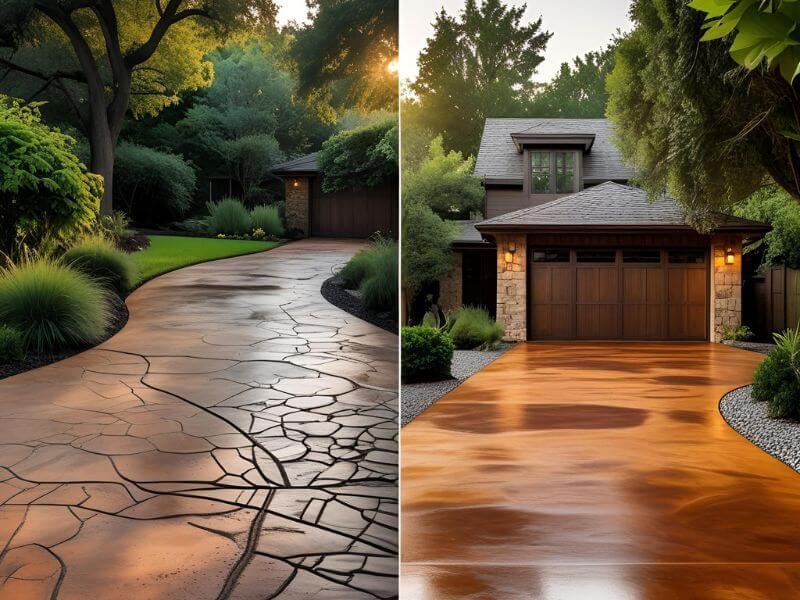
When you're looking to transform your concrete patio, driveway, or outdoor surface, the choice between painting and staining can feel overwhelming. We understand this dilemma because at Driveway Painting, we help homeowners make this decision every day. Both options can dramatically improve your property's appearance, but they work in completely different ways.
The short answer? It depends on what you want to achieve. Paint offers bold, uniform colour coverage, while concrete stain creates natural-looking, variegated finishes that enhance your concrete's existing character. Let's explore both options so you can make the right choice for your home.
Before diving into which option suits your needs, it's important to understand how these two products actually work on your concrete surface. Is it better to paint or stain outdoor concrete? The answer depends on factors like appearance, durability, and maintenance requirements.
Concrete paint sits on top of your concrete surface, creating a protective coating that completely covers the existing appearance. Think of it like putting a coloured blanket over your concrete floor. This coating can handle extreme weather conditions and provides excellent protection against UV rays, moisture, and everyday wear.
Concrete stain, on the other hand, penetrates into the concrete surface itself. Rather than covering your concrete, it actually soaks in and becomes part of the material. The stain penetrates up to ¼ inch into the surface, making it incredibly durable and resistant to fading or peeling.
Over 40% of homeowners now choose coloured or decorative coatings instead of plain concrete, opting for attractive tones like slate, terracotta, charcoal, or sandstone. This growing trend reflects how these treatments can transform ordinary concrete into something truly special.
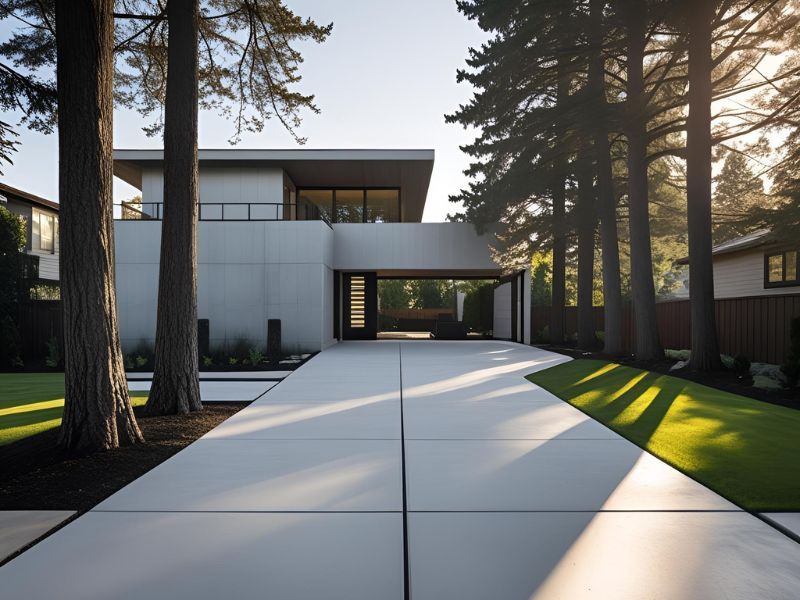
Concrete paint excels when you want complete colour transformation. If your concrete patio has stains, discolouration, or an uneven appearance, paint provides the coverage needed to create a uniform finish.
Paint works particularly well for:
Latex paints offer easy application and cleanup, making them popular for DIY projects. However, they may not provide the same durability as other options in harsh weather conditions.
Oil based paint delivers superior adhesion and durability. These paints resist chipping and peeling better than latex alternatives, though they require more careful application and proper ventilation during the curing process.
Epoxy-based coatings provide the most durable finish available. These create an extremely hard surface that resists chemicals, abrasion, and moisture penetration.
A professionally applied concrete paint typically lasts 5–7 years with proper maintenance. Is painting a driveway a good idea? The key to long-lasting results lies in proper preparation of the concrete surface. Most DIY painting projects fail because homeowners skip essential steps like acid etching or thorough power washing, which leads to poor adhesion and early paint peeling.
Multiple coats are usually necessary for optimal coverage and durability. The base coat provides adhesion, while subsequent coats build thickness and colour depth.
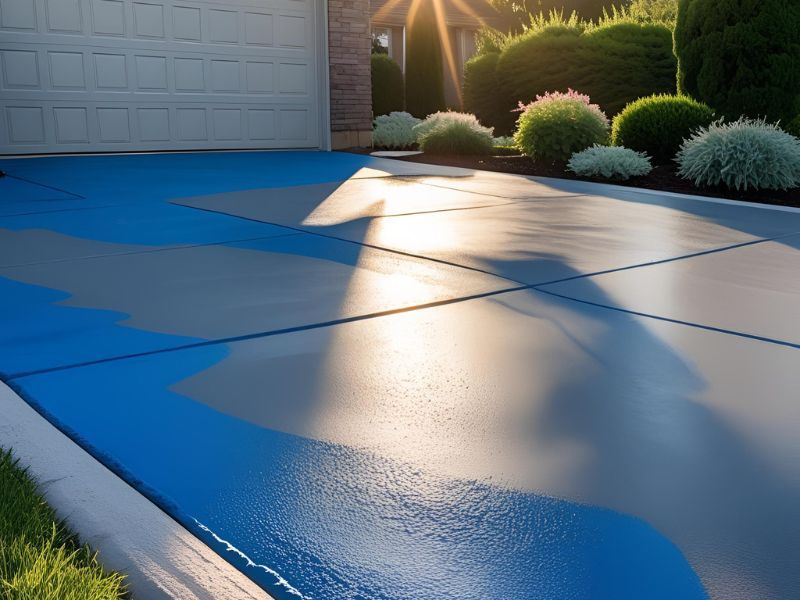
Concrete stain works by chemically bonding with the concrete surface. Acid stain creates a chemical reaction that produces permanent colour changes, while water-based stains penetrate deeply to provide long-lasting colour.
Because the stain penetrates rather than coats, it won't chip or peel like paint can. This makes stained concrete an excellent choice for high-traffic areas and exterior applications where durability matters most.
Acid stain creates unique, marbled effects that mimic natural stone. Each application produces slightly different results because the acid reacts with minerals already present in your concrete. No two stained concrete surfaces look exactly the same, giving your patio or driveway a truly one-of-a-kind appearance.
Water-based stains offer more predictable colour results and come in a wider range of colours. They're also more environmentally friendly, with lower volatile organic compounds compared to other staining options.
Concrete dye provides the most vibrant colours but penetrates less deeply than traditional stains. It's often used in combination with other staining methods for unique effects.
Acid-based or water-based stains can last up to 10 years or more with proper sealing. The natural texture of the concrete remains visible, creating an authentic stone-like appearance that actually improves with age. Many people often wonder, do you need to seal concrete after painting?—and while staining is a different process, the answer highlights the importance of sealing for both durability and appearance.
The stained concrete develops character over time, with subtle variations that enhance rather than detract from its appearance. This makes it particularly appealing for homeowners seeking a natural look that complements landscaping and architectural features.
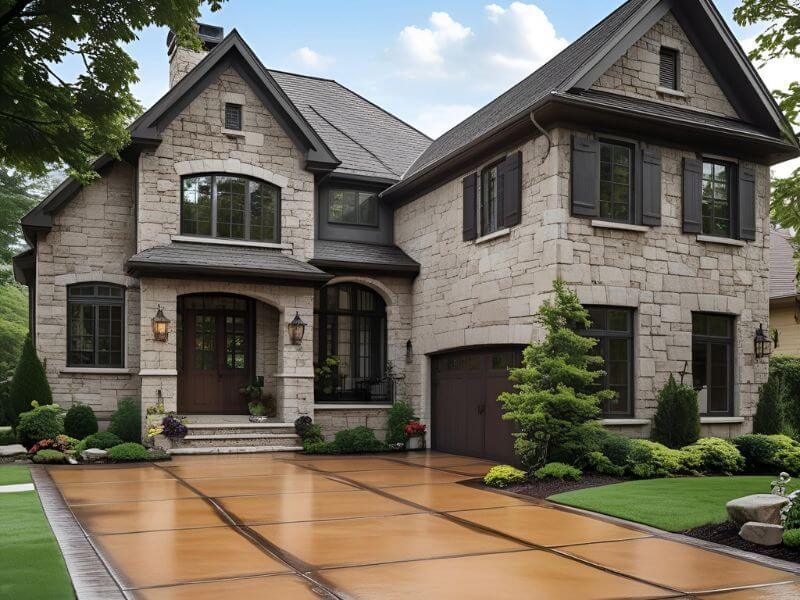
The application process for both paint and stain requires similar preparation work. Proper preparation accounts for roughly 70% of any successful painting project, whether you're applying paint or stain.
Homeowners can see up to 150% ROI from driveway painting or staining, especially when improving kerb appeal before selling their home. This makes either option a smart investment in your property's value.
Both paint and stain require thorough cleaning and preparation. The concrete surface must be free of oil, grease, and previous coatings. Muriatic acid is often used for etching, creating the slightly rough surface needed for proper adhesion.
Paint application typically requires multiple coats for complete coverage. Each coat must dry completely before applying the next, extending the overall project timeline.
Stain application is generally simpler, often requiring just one coat. However, achieving even coverage requires experience, as stain can create blotchy results if not applied properly.
Paint provides a fresh coat appearance that looks uniform and clean. However, it may show wear patterns over time, particularly in high-traffic areas. Homeowners often wonder, how long should a painted driveway last? When paint does wear, it often requires complete removal and reapplication.
Stained concrete ages gracefully. Because the colour is embedded in the concrete itself, normal wear doesn't dramatically change the appearance. Touch-ups are rarely needed, and maintenance typically involves only occasional cleaning and resealing.
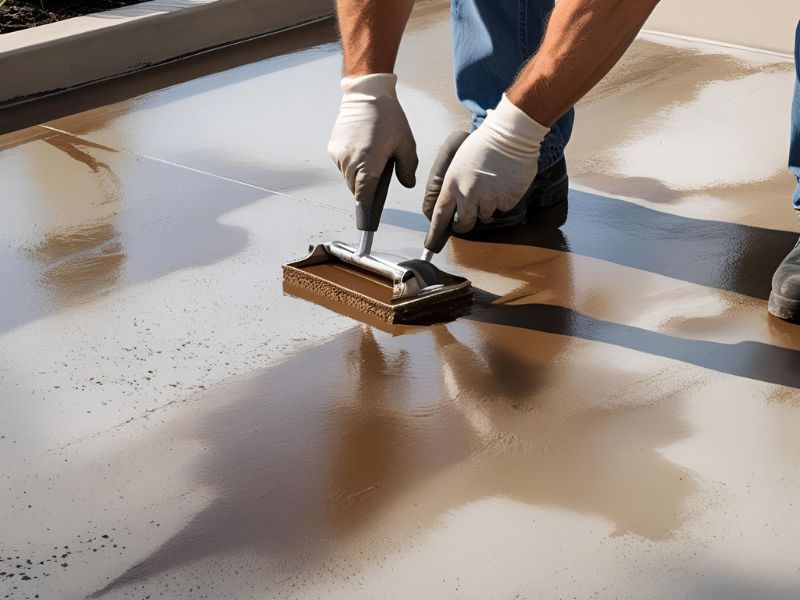
UK weather presents unique challenges for outdoor concrete surfaces. Over 60% of visible driveway damage comes from UV exposure and moisture penetration, both of which can be effectively blocked with either paint or stain when properly sealed.
Harsh weather conditions affect paint and stain differently. Paint may be more susceptible to temperature cycling, which can cause expansion and contraction that leads to cracking or peeling.
Stain's deep penetration makes it naturally more resistant to freeze-thaw cycles common in British winters. The concrete surface maintains its natural ability to breathe, reducing moisture-related problems.
The current condition of your concrete surface significantly influences which option will work best. Heavily stained or damaged concrete may require paint's covering power to achieve acceptable results.
New concrete needs time to cure completely before either treatment. Most manufacturers recommend waiting at least 28 days after pouring before applying paint or stain.
Existing concrete often benefits from power washing or acid etching to ensure proper adhesion. This preparation step is crucial for both paint and stain applications.
Paint offers solid colour coverage with consistent appearance across the entire surface. This works well for contemporary designs or situations where you want the concrete surface to match specific colour schemes.
Stain provides variegated, natural-looking results that highlight the concrete's inherent character. The earthy tones and subtle variations complement traditional architecture and natural landscaping beautifully.
Consider how the finished surface will coordinate with your home's exterior, landscaping, and overall design aesthetic. Both options can be beautiful, but they create very different visual effects.
Professional application ensures proper surface preparation, which determines the longevity of any concrete coating project. Professionals understand how different factors like concrete age, existing conditions, and local climate affect application success.
We see many DIY projects that fail because homeowners underestimate the importance of preparation work. Skipping steps like proper cleaning, etching, or primer application leads to premature failure regardless of whether you choose paint or stain.
Professional application also includes proper safety measures. Working with muriatic acid and other chemicals requires appropriate protective equipment and ventilation.
The square foot area of your project influences both material costs and application complexity. Larger projects often benefit more from professional application because consistent results become more challenging as project size increases.
Temperature and humidity during application affect how both paint and stain cure. Professionals can adjust application techniques and timing to accommodate weather conditions for optimal results.
Other factors include the concrete's porosity, age, and any previous treatments. Each of these variables can significantly impact how paint or stain performs on your specific surface.

Paint works best when you need complete colour coverage or want to match specific design elements. It's ideal for surfaces with existing stains or damage that need to be hidden.
Paint also excels in situations where you want easy maintenance and the ability to change colours in the future. A durable finish from quality paint provides years of protection with minimal upkeep.
Consider paint for pool decks or other areas where slip resistance is important. Modern concrete paints can include anti-slip additives for enhanced safety.
Stain creates the perfect choice for homeowners wanting authentic, natural-looking results. The long lasting finish develops character over time while requiring minimal maintenance.
Stain works beautifully when you want to enhance rather than hide your concrete's natural texture. The resulting surface looks like expensive stone or marble for a fraction of the cost.
Choose stain for areas where durability is paramount. Because stain penetrates the concrete surface, it won't chip or peel like surface coatings can.
Some homeowners choose to combine approaches, using stain for base colour and protective topcoats for added durability. This can provide both the natural appearance of stain and the protective benefits of quality coatings.
Future maintenance differs significantly between the two options. Paint may require periodic touch-ups or complete reapplication, while stained surfaces typically need only occasional cleaning and resealing.
Choosing between paint and stain represents just the first step in transforming your concrete surfaces. Proper preparation, quality materials, and skilled application determine whether your project delivers the beautiful, long-lasting results you want.
At Driveway Painting, we understand that every property is unique. We evaluate your specific concrete surface, consider your aesthetic goals, and recommend the approach that will deliver the best results for your situation. Our experience with both painting and staining ensures your project will enhance your property's value and appearance for years to come.
Whether you choose the bold coverage of concrete paint or the natural beauty of concrete stain, professional application ensures optimal results. Contact Driveway Painting today for your free quote and discover how we can transform your concrete surfaces into beautiful, durable features that enhance your home's kerb appeal.